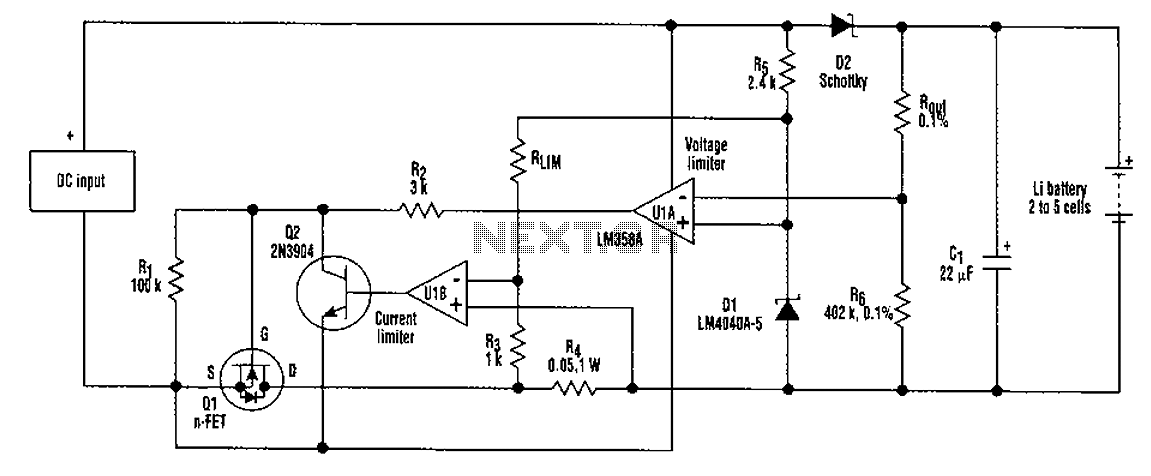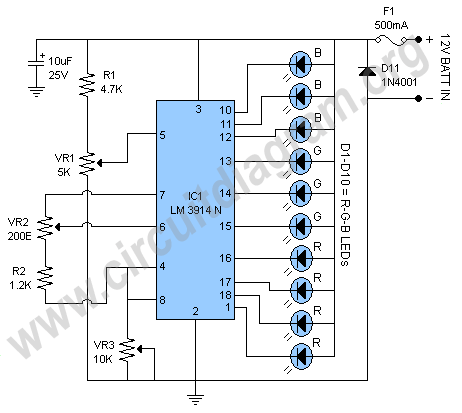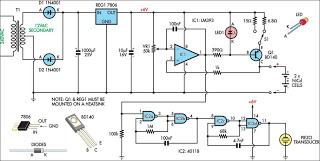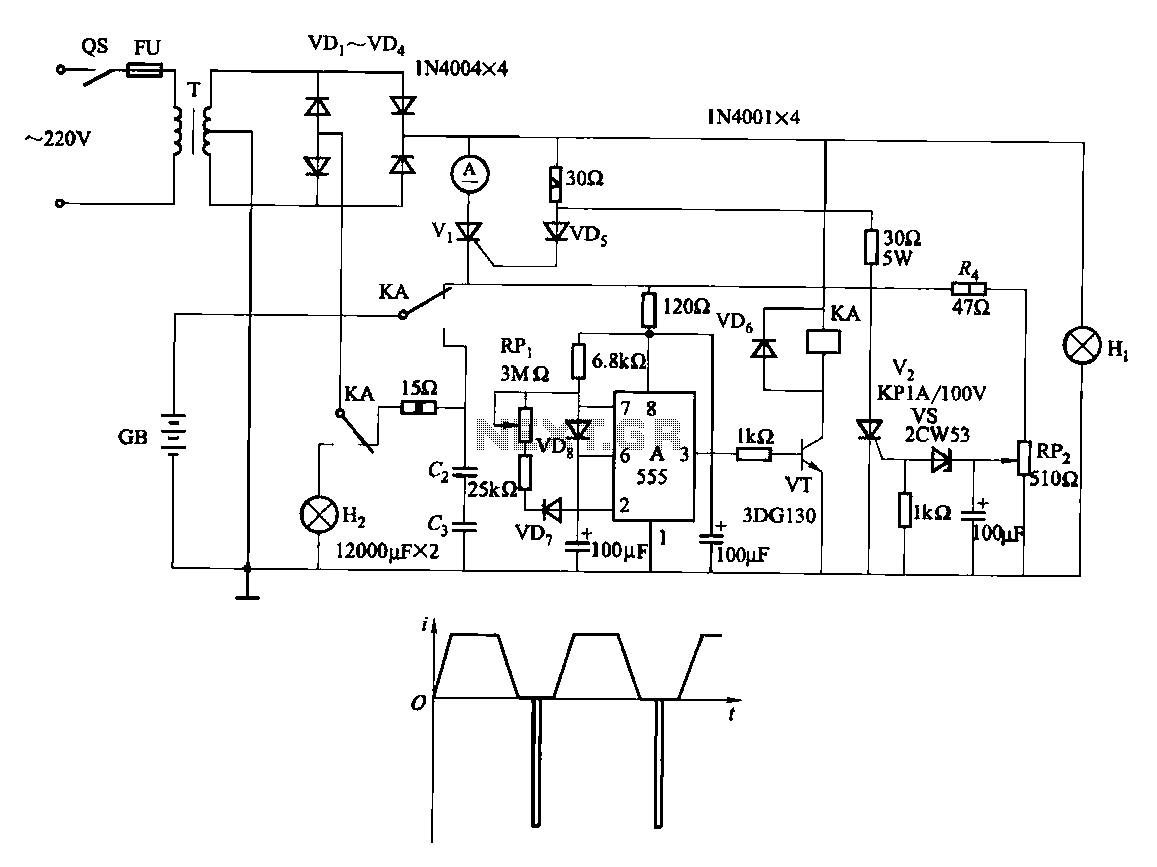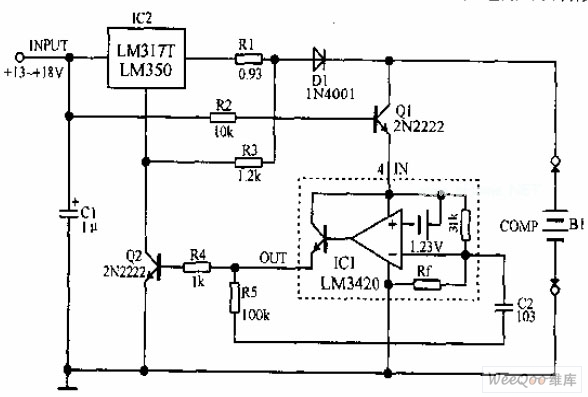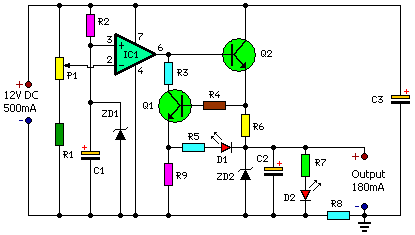
Cost-effective nickel-cadmium battery charger LM393
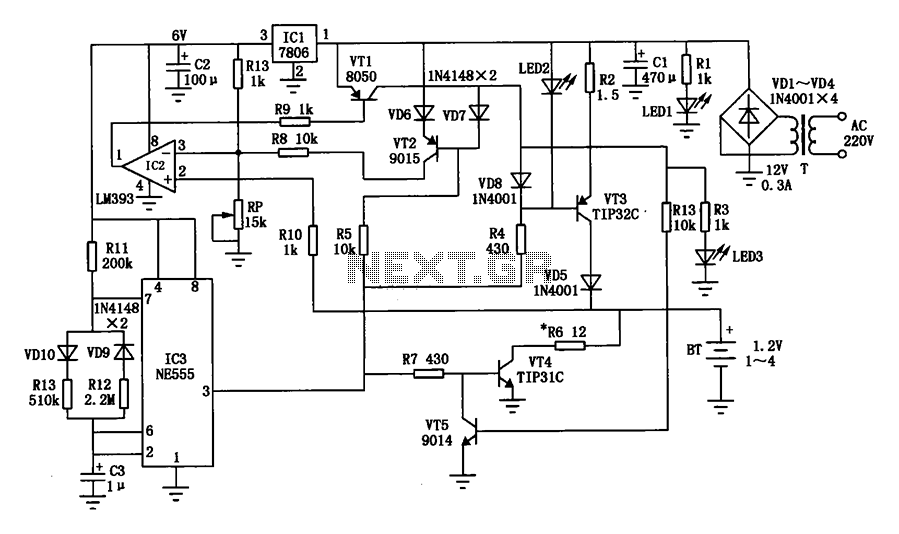
A cost-effective nickel-cadmium battery charger using the LM393, featuring the following characteristics: (1) It provides constant current charging interspersed with high current discharge. The charging current is approximately 300mA, while the discharge current increases with battery voltage, reaching nearly 400mA at full discharge. The charging interval is 1.5 seconds, followed by a 0.5-second discharge interval. After the high-current charging phase, a trickle charge of about 5mA is applied. (2) The charger detects battery voltage during discharge; since the charging voltage remains higher than the discharge voltage, any discrepancies in the actual cell state are identified, reflecting the battery's discharge capacity. (3) The charger is compatible with 1 to 4 rechargeable nickel-cadmium batteries, with a charging time of approximately two hours for 500mAh batteries, meeting general usage requirements.
The LM393-based nickel-cadmium battery charger is designed to efficiently manage the charging and discharging cycles of nickel-cadmium batteries. The architecture utilizes the LM393 comparator to monitor voltage levels and control the charging process. The constant current charging feature ensures that batteries receive a steady 300mA until they reach a predetermined voltage threshold. This is crucial for maintaining battery health and optimizing charging times.
During the charging cycle, the charger alternates between charging and discharging phases. The 1.5-second charging interval followed by a 0.5-second discharge interval allows for effective monitoring of the battery's state. As the battery approaches full charge, the discharge current can peak at 400mA, which aids in determining the battery's capacity and readiness for use.
The trickle charge of 5mA applied after the high-current charging phase helps to maintain the battery's charge without overloading it, thereby extending the lifespan of the battery. The charger can accommodate between one to four nickel-cadmium cells, making it versatile for various applications. For a typical 500mAh nickel-cadmium battery, the estimated charging time of two hours is efficient for general consumer needs, ensuring that batteries are ready for use in a timely manner.
Overall, this design provides a reliable and cost-effective solution for charging nickel-cadmium batteries, combining efficiency with user-friendly operation. The ability to detect battery voltage during discharge enhances the charger's functionality, allowing it to adapt to the battery's condition dynamically.Cost-effective nickel-cadmium battery charger LM393 constructed as shown, it has the following characteristics: (1) constant current charging interspersed with large current di scharge, constant current charging current of about 300mA, the discharge current as the battery voltage increases and increased nearly full battery discharge current up to 400mA. Charging 1.5 seconds, 0.5 seconds discharge, intervals. After the high-current charging is completed, about 5mA trickle charge. (2) the detection of the battery voltage when the discharging is carried out, because the charging voltage is always higher than the discharge voltage, when charging is detected as the actual cell state error, but also reflects the battery is detected during discharge capacity.
(3) rechargeable batteries can be 1-4, for 500mAh nickel-cadmium batteries, the charging time is about two hours, to meet the general needs.
The LM393-based nickel-cadmium battery charger is designed to efficiently manage the charging and discharging cycles of nickel-cadmium batteries. The architecture utilizes the LM393 comparator to monitor voltage levels and control the charging process. The constant current charging feature ensures that batteries receive a steady 300mA until they reach a predetermined voltage threshold. This is crucial for maintaining battery health and optimizing charging times.
During the charging cycle, the charger alternates between charging and discharging phases. The 1.5-second charging interval followed by a 0.5-second discharge interval allows for effective monitoring of the battery's state. As the battery approaches full charge, the discharge current can peak at 400mA, which aids in determining the battery's capacity and readiness for use.
The trickle charge of 5mA applied after the high-current charging phase helps to maintain the battery's charge without overloading it, thereby extending the lifespan of the battery. The charger can accommodate between one to four nickel-cadmium cells, making it versatile for various applications. For a typical 500mAh nickel-cadmium battery, the estimated charging time of two hours is efficient for general consumer needs, ensuring that batteries are ready for use in a timely manner.
Overall, this design provides a reliable and cost-effective solution for charging nickel-cadmium batteries, combining efficiency with user-friendly operation. The ability to detect battery voltage during discharge enhances the charger's functionality, allowing it to adapt to the battery's condition dynamically.Cost-effective nickel-cadmium battery charger LM393 constructed as shown, it has the following characteristics: (1) constant current charging interspersed with large current di scharge, constant current charging current of about 300mA, the discharge current as the battery voltage increases and increased nearly full battery discharge current up to 400mA. Charging 1.5 seconds, 0.5 seconds discharge, intervals. After the high-current charging is completed, about 5mA trickle charge. (2) the detection of the battery voltage when the discharging is carried out, because the charging voltage is always higher than the discharge voltage, when charging is detected as the actual cell state error, but also reflects the battery is detected during discharge capacity.
(3) rechargeable batteries can be 1-4, for 500mAh nickel-cadmium batteries, the charging time is about two hours, to meet the general needs.
